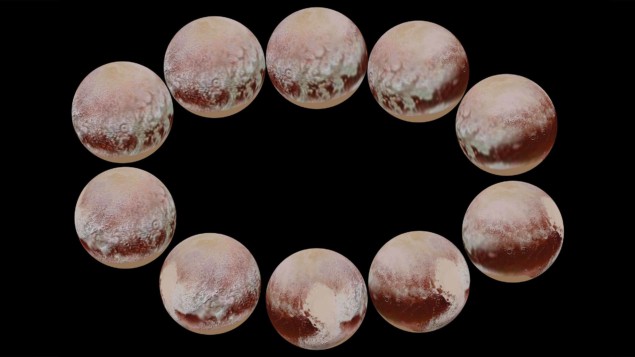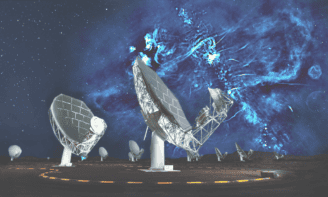Louisa Preston reviews Chasing New Horizons: Inside the Epic First Mission to Pluto by Alan Stern and David Grinspoon

I am not usually a fan of knowing the ending to a story before I have read it. But despite the globally publicized and incredible outcome of one of the most celebrated NASA missions in recent years, Chasing New Horizons: Inside the Epic First Mission to Pluto by Alan Stern and David Grinspoon, is a thrilling tale of how this huge success came to be. In the summer of 2015, more than three billion miles from Earth and after a 9.5-year journey, New Horizons – the fastest spacecraft ever to leave our planet – screamed past the dwarf-planet Pluto and its moon Charon, finally unveiling these far-away icy worlds that have long evaded our Earth-bound cameras.
Unlike nearly every other popular-science book, Chasing New Horizons is written and reads like a novel. The easy, comfortable and accessible language draws you into the life story of Alan Stern, the not-always-fearless leader of the NASA mission, as told by his friend and formidable astrobiologist David Grinspoon. Grinspoon was peripherally involved with the mission itself, but acts as the book’s narrator, sharing the story from the perspective of Stern as told to him through phone conversations the two had every Saturday morning for a year and a half. Their goal is to give us a sense of what it took to get this landmark mission off the ground, sharing the good, bad and ugly sides of scientific exploration and bureaucracy, and to tell the largely untold story of how icy Pluto actually came to be explored.
We start with a brief introduction, as all good space books seem to have, on the history of missions to explore the solar system, in which the authors explain why Pluto was not seen as a priority for so long. What is interesting here is the detailed timeline of discoveries – from Pluto’s confirmed discovery in 1930, until it finally moved up the chain to become a fundable project. In the 1950s Pluto’s length of day was calculated as being 6.4 times as long as Earth’s. In the 1970s scientists revealed that the planet was small and had a reddish hue; they found subtle fingerprints of frozen natural gas on its surface; and discovered that it had a moon. A few years after the discovery of this moon, dubbed Charon, astronomers noticed that the pair were about to start repeatedly eclipsing each other every few days, for up to six years, creating a scientific bonanza. This spawned a whole generation of “Plutophiles” and the seeds for a mission to explore it were sown in the late 1980s.
What follows next however is the story of decades of disappointment and a real insight into how hard it is to get any space mission off the ground. Going into this part of the book, I thought I would be a bit bored – who really wants to read about funding wars and academic rivalries? Well, it turns out that I do. The narrative of this part of the story is incredibly emotive and almost exciting. Grinspoon portrays NASA’s Jet Propulsion Laboratory staff as the villains – trying to control and influence a project that was never theirs to begin with. His obviously biased view positions Stern as the hero – a veritable rebel fighting “the establishment”.
This battle of good versus supposed evil is played out through the story of funding wars, institutional grudge matches and politics until, in 2003, 14 years after it all began for Stern, good finally triumphed. The real hero of this tale, however, is the Maryland senator Barbara Ann Mikulski. A Democrat and a member of House of Representatives from 1977 to 1987, Mikulski championed and supported New Horizons from the beginning, both financially and within the Senate. Without her there might never have been a New Horizons.
We then follow the building of the spacecraft, its launch on 19 January 2006 and its journey to Pluto. The book discusses the precarious and precise nature of the Jupiter fly-by and gravity assist, and describes how through “pure dumb luck” the New Horizons team managed to image a time-lapse sequence of a volcano erupting on Jupiter’s moon Io. Grinspoon reveals the number of panics the team had when the main computer suddenly rebooted and went into safe mode, hypothesized to be due to radiation damage associated with Jupiter’s powerful magnetosphere. Grinspoon also talks about one of the truly innovative aspects of New Horizons – its ability to go into hibernation. Using the analogy of a television, Grinspoon asks the reader to imagine a scenario in which they bought a TV in January 2006 and still expect it to be operational in mid-2015. Would it be better to leave it on continuously for those nine and a half years, or to turn it off and check in on it periodically? The team’s engineers clearly thought the latter was the better option. Thanks to this protocol, the spacecraft and its primary systems had only clocked 3.5 years’ worth of use when New Horizons reached Pluto, despite being nearly 10 years old.
The rest, as they say, is history. New Horizons transmitted spectacular images back to Earth following its 2015 fly-by of Pluto, reawakening a dormant public fascination with space exploration and dramatically increasing our scientific knowledge of the distant reaches of the solar system. The interplanetary craft is now on a five-year extended mission to do a New Year 2019 fly-by of an ancient Kuiper Belt Object, 2014 MU69, a billion miles further out than Pluto. Power and fuel projections indicate that – with continuing funding and motivation – New Horizons could operate into the mid-2030s, exploring the nearest reaches of interstellar space.
This book is really Grinspoon and Stern’s chance to pay homage to the thousands of people who played a part in making this mission a success
I highly recommend Chasing New Horizons, which is sure to teach you something new. Did you know that the ninth planet in our solar system was given the name “Pluto” not just because it followed the naming convention of classical deities, but because the first two letters, PL, served nicely to honour astronomer Percival Lowell, who first began the search for a ninth planet? Me neither. Be warned though – if you are looking for a book about Pluto itself then this isn’t the one for you (despite the many beautiful colour inserts and appendix of top 10 findings). I feel this book is really Grinspoon and Stern’s chance to pay homage to the thousands of people who played a part in making this mission a success, not least their families; when you take on the time commitment of a space mission, so do your nearest and dearest. As a scientist working on space missions myself, I recognize this story all too well, both the positives and the many negatives. Yet Stern’s hands-on and infectious passion when talking about New Horizons enables him to make even the potentially dull material – seeking committee approvals, and managing academic and personal relationships – as interesting as the science.
- 2018 Picador 320pp £21.99hb



